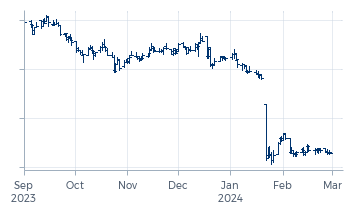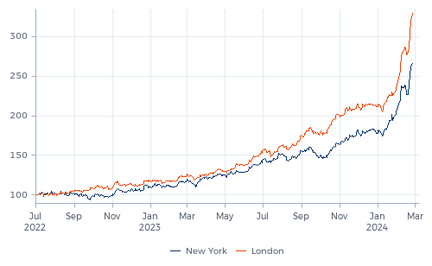How to profit from trends?
A look at the diversity of trend-following CTAs.

A look at the diversity of trend-following CTAs.

Potential clients often ask us questions about our trading systems. Are they fast or slow, or some kind of mixture? How do they differ from the trading systems of other CTAs? How many different systems do we use? How often do we change or even replace them?
We understand why investors ask these questions; our trading systems determine our positions, don’t they? However, we believe that to understand the characteristics of a diversified trend program like ours, the role of the trading systems — or trend identification tools, as we like to call them — that indicate the entry and exit points of individual trades is easily overestimated. Some other choices are more decisive. A few recent examples will hopefully make this clear.
The most profitable trade of our Diversified Trend Program (DTP) within equity markets in January 2024 was a short trade in Archer-Daniels-Midland (ADM).¹ The stock tumbled after the company suspended its CFO and delayed its quarterly earnings release pending an investigation into its accounting practices in its nutrition business. A quick look at the stock’s price chart² shows why a trend-following trading program will have profited from that. It makes little difference whether a short-term or a long-term trading system was used, or whether the system looked for traditional breakout patterns or was based on moving averages; a trend-following program could only have been short this stock.

That is, if the program traded this particular market. We actually think that most CTA programs only trade this stock as part of an index. This applies among others to all programs that do not trade single stocks. It may sound trivial, but no trading program can profit from a trend in a market that is not traded. Not directly, at least. This means that the choice of the investment universe may be a more decisive factor for individual programs’ returns than the choice of the trading systems used.
But in order for DTP to profit from this ADM short trade in January as much as it did, it wasn’t enough to just include the stock in the program’s investment universe. Once the trading systems recognized the downtrend, the short position also had to be sized sufficiently large for it to be able to really move the needle. For a program that trades a few hundred individual stocks along with dozens of stock indices, and with most of the risk not even allocated to stock markets, it’s not obvious that this one individual position was as large as it was. Given our investment style (diversified trend-following), it would not have been strange if the size of this position had been only one-tenth of its actual size. Also with regard to position sizing, different managers make different choices. And we believe that these choices also tend to have a bigger effect on a trend program’s characteristics than the trading systems used.
DTP’s most profitable trade in January (and again in February) was a long trade in cocoa. The reason for this long-running uptrend will be known: because prices had been too low for too long, farmers couldn’t afford to invest in making their fields resilient enough to withstand regular adversity from diseases and unfavorable weather. Also throughout 2023, long positions in New York and London cocoa were DTP’s most profitable trades by far. Looking at cocoa’s price charts, it seems almost impossible that a trend-following trading program would not have profited from most of this trend, regardless of its specific trend identification techniques.

This again assumes that these markets were part of the program’s investment universe. As these are two of the oldest futures contracts, it’s unlikely that any of the older CTAs would not trade them. However, some newer CTAs might have avoided them. Learning why CTAs opt(ed) to trade cocoa, or not, could reveal more about their programs than knowing the details of their trading systems.
But the main factor behind the dispersion in profits in this cocoa trend was probably the size of the position rather than the decision to trade the market or not. Even if DTP’s position had been only one-fifth of the actual size, the program would still have easily qualified as a diversified trend program. As mentioned earlier, different managers make different choices in this regard, which can occasionally lead to significant differences in position sizes, even among managers who are positioned in the same trends in the same markets.
We think that the managers who profited a lot from the cocoa trend were largely different managers than those who profited a lot from the ADM trend. It is not by chance that our DTP profited from both. Within the Commodity Trading Advisor space, Transtrend probably has a bit more of the (agricultural) Commodity in the program than most of our peers. This comes from our origin. Transtrend started life as a research project in an agricultural commodities trading house that was not fundamentally different from ADM. We already traded commodity futures before launching DTP. These markets were our bread and butter. This is our home ground.
To understand the DNA of DTP, knowing what my surname means is probably more informative than analyzing the master theses of our researchers. Growing up on a dairy farm instills a completely different attitude towards risk than growing up on an arable farm. And growing up in a city produces yet a different breed of investors and traders, creating different CTA programs that will likely perform better on different home grounds.
And this brings us to the title of this short piece: How to profit from trends? There’s no single answer to this question. Different CTAs will do so in different ways, at different times, and on different home grounds. Together, these diverse managers create a colorful landscape of CTAs, providing even more opportunity for diversification to end-investors than the various CTA indices already demonstrate.
¹ Transtrend’s Diversified Trend Program only trades single stocks through total return swaps and stock indices through futures contracts.
² Source of price data used in the graphs in this article: Refinitiv, Bloomberg and Transtrend.